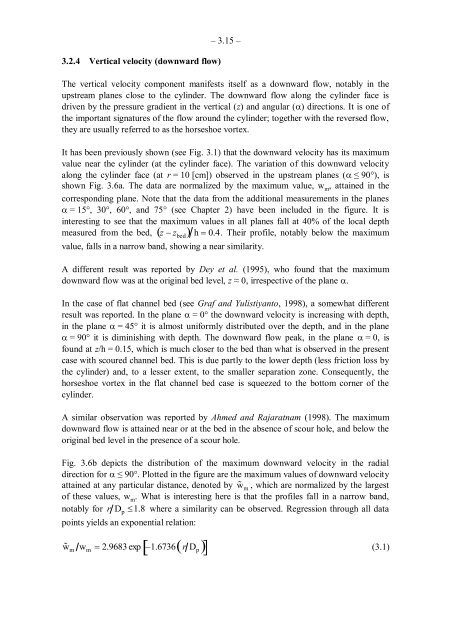You also want an ePaper? Increase the reach of your titles
YUMPU automatically turns print PDFs into web optimized ePapers that Google loves.
3.2.4 Vertical velocity (downward flow)<br />
– 3.15 –<br />
The vertical velocity component manifests itself as a downward flow, notably in the<br />
upstream planes close to the cylinder. The downward flow along the cylinder face is<br />
driven by the pressure gradient in the vertical (z) and angular (�) directions. It is one of<br />
the important signatures of the flow around the cylinder; together with the reversed flow,<br />
they are usually referred to as the horseshoe vortex.<br />
It has been previously shown (see Fig. 3.1) that the downward velocity has its maximum<br />
value near the cylinder (at the cylinder face). The variation of this downward velocity<br />
along the cylinder face (at r = 10 [cm]) observed in the upstream planes (� ≤ 90°), is<br />
shown Fig. 3.6a. The data are normalized by the maximum value, wm , attained in the<br />
corresponding plane. Note that the data from the additional measurements in the planes<br />
� = 15°, 30°, 60°, and 75° (see Chapter 2) have been included in the figure. It is<br />
interesting to see that the maximum values in all planes fall at 40% of the local depth<br />
measured from the bed, �z � zbed� h � 0.4. Their profile, notably below the maximum<br />
value, falls in a narrow band, showing a near similarity.<br />
A different result was reported by Dey et al. (1995), who found that the maximum<br />
downward flow was at the original bed level, z ≈ 0, irrespective of the plane �.�<br />
In the case of flat channel bed (see Graf and Yulistiyanto, 1998), a somewhat different<br />
result was reported. In the plane � = 0° the downward velocity is increasing with depth,<br />
in the plane � = 45° it is almost uniformly distributed over the depth, and in the plane<br />
� = 90° it is diminishing with depth. The downward flow peak, in the plane � = 0, is<br />
found at z/h = 0.15, which is much closer to the bed than what is observed in the present<br />
case with scoured channel bed. This is due partly to the lower depth (less friction loss by<br />
the cylinder) and, to a lesser extent, to the smaller separation zone. Consequently, the<br />
horseshoe vortex in the flat channel bed case is squeezed to the bottom corner of the<br />
cylinder.<br />
A similar observation was reported by Ahmed and Rajaratnam (1998). The maximum<br />
downward flow is attained near or at the bed in the absence of scour hole, and below the<br />
original bed level in the presence of a scour hole.<br />
Fig. 3.6b depicts the distribution of the maximum downward velocity in the radial<br />
direction for � ≤ 90°. Plotted in the figure are the maximum values of downward velocity<br />
attained at any particular distance, denoted by w ˜ m , which are normalized by the largest<br />
of these values, wm . What is interesting here is that the profiles fall in a narrow band,<br />
notably for r Dp �1.8 where a similarity can be observed. Regression through all data<br />
points yields an exponential relation:<br />
w ˜ m wm � 2.9683 exp �1.6736 r Dp � � ��<br />
(3.1)

















